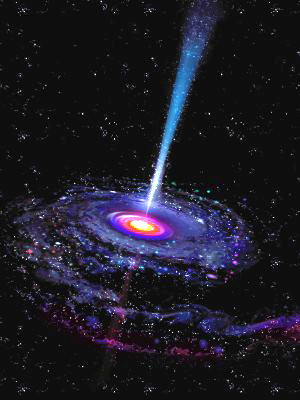For Fully Mature Black Holes, Time Stands Still

The end of a black hole’s evolution may be a mind-bending kind of space-time independent of time. A new study proposes a method to tell how far any black hole is from reaching this end state.
Black holes are some of the weirdest things in the universe. They occur when mass is packed into a tiny volume, squished to its ultimate density.
Though observations suggest black holes are prevalent in the universe, scientists still don't really understand what goes on inside them. The equations of general relativity usually used to understand the physics of the universe break down in these cases.
"It is really beyond the physics we know," said Juan Antonio Valiente Kroon, a mathematician at Queen Mary, University of London. "To understand what happens inside a black hole, we need to invent new physics."
Mercifully, the physics for the end state of a black hole is somewhat simpler. A solution to the equations of general relativity was found that produced a situation called "Kerr spacetime." Scientists now think Kerr spacetime is what happens when a black hole has reached its final evolutionary state.
"Mainly the equations of relativity are so complex that for relativistic systems, the only way you can probe these equations is by means of computer," Valiente Kroon told SPACE.com. "Solutions like this Kerr solution are really exceptional. The Kerr solution is one of the few explicitly known solutions to general relativity that have a direct physical meaning."
Kerr spacetime is time-independent, meaning that nothing in Kerr spacetime changes over time. In effect, time stands still. A black hole in such a state is essentially stationary.
Get the Space.com Newsletter
Breaking space news, the latest updates on rocket launches, skywatching events and more!
"One could say once it has reached this stage, there are no further processes taking place," Valiente Kroon said.
In their new study, Valiente Kroon and Thomas Backdahl, his colleague at Queen Mary, have calculated a formula to determine how close a black hole is to reaching the Kerr state.
This can happen very quickly – even in seconds – depending on the object's mass.
To apply the formula, scientists would examine the region around a black hole called its event horizon. Once mass, or even light, passes within the event horizon of a black hole, it cannot escape the black hole's gravitational clutches.
The researchers think their development could aid scientists who are building computer simulations of black holes and aiming to align them with observations of actual black holes.
Astronomers think most galaxies, including our own Milky Way, host supermassive black holes in their centers. Some researchers suspect that these are actually Kerr black holes.
Valiente Kroon and Backdahl detail their work in the Jan. 19 issue of the journal Proceedings of the Royal Society A.
You can follow SPACE.com senior writer Clara Moskowitz on Twitter @ClaraMoskowitz.
Join our Space Forums to keep talking space on the latest missions, night sky and more! And if you have a news tip, correction or comment, let us know at: community@space.com.

Clara Moskowitz is a science and space writer who joined the Space.com team in 2008 and served as Assistant Managing Editor from 2011 to 2013. Clara has a bachelor's degree in astronomy and physics from Wesleyan University, and a graduate certificate in science writing from the University of California, Santa Cruz. She covers everything from astronomy to human spaceflight and once aced a NASTAR suborbital spaceflight training program for space missions. Clara is currently Associate Editor of Scientific American. To see her latest project is, follow Clara on Twitter.









